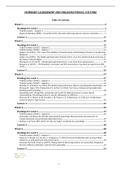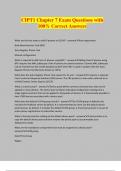SUMMARY LEADERSHIP AND ORGANISATIONAL CULTURE
Table of Contents
Week 1 ..................................................................................................................................................... 2
Readings for week 1 ................................................................................................................................ 2
Yukl & Gardner – Chapter 1 ................................................................................................................................................... 2
Magee & Galinsky (2008) – Social Hierarchy: the self-reinforcing nature of power and status.............. 7
Lecture 1.................................................................................................................................................... 11
Week 2 ...................................................................................................................................................12
Readings for week 2 .............................................................................................................................. 12
Yukl & Gardner (2020) – chapter 2 ..................................................................................................................................19
Yukl & Gardner (2020) – chapter 7 ..................................................................................................................................12
Judge et al. (2004) – The Ones? The Validity of Consideration and Initiating Structure in Leadership
Research. ......................................................................................................................................................................................22
Judge et al. (2009) - The bright and dark sides of leader traits: A review and theoretical extension of
the leader trait paradigm ......................................................................................................................................................15
Thompson et al. (2015) – Situational leadership theory: a test from three perspectives ........................23
Zhang et al. (2017) – CEO humility, narcissism and firm innovation: A paradox perspectiveon CEO
traits. ..............................................................................................................................................................................................25
Lecture 2.................................................................................................................................................... 26
Week 3 ...................................................................................................................................................27
Readings for week 3 .............................................................................................................................. 27
Yukl & Gardner (2020) – chapter 4 ..................................................................................................................................27
Yukl & Gardner (2020) – chapter 6 ..................................................................................................................................32
Benoliel, P. & Somech, A. (2014). The health and performance effects of participative leadership ....36
Cheong, M., Spain, S.M., Yammarino, F.J., & Yun, S. (2016). Two faces of empowering leadership:
Enabling and burdening. .......................................................................................................................................................38
Haselhuhn, M.P., Wong, E.M., & Ormiston, M.E. (2017). With great power comes shared
responsibility: Psychological power and the delegation of authority. ..............................................................39
Mawritz, M. G., Mayer, D. M., Hoobler, J. M., Wayne, S. J., & Marinova, S. J. (2012). A trickle-down
model of abusive supervision. ............................................................................................................................................40
Lecture 3.................................................................................................................................................... 42
Week 4 ...................................................................................................................................................43
Readings for week 4 .............................................................................................................................. 43
Yukl & Gardner (2020) – chapter 8 ..................................................................................................................................43
Antonakis, J. & House, R.J. (2014). Instrumental leadership: Measurement and extension of
transformational-transactional leadership theory. ...................................................................................................45
Barling, J., & Frone, M.R. (2017). If only my leader would just do something! ..............................................46
Lecture 4.................................................................................................................................................... 48
Week 5 ...................................................................................................................................................48
Readings for week 5 .............................................................................................................................. 48
Yukl & Gardner (2020) – chapter 9 ..................................................................................................................................48
Liden, R. C. Wayne, S., J. & Liao, C., & Meuser, J. D. (2014). Servant leadership and serving culture:
Influence on individual and unit performance. ...........................................................................................................50
Lemoine, Hartnell, & Leroy, (2019). Taking Stock of Moral Approaches to Leadership: Integrative
Review of Ethical, Authentic, and Servant Leadership. ...........................................................................................52
Lecture 5.................................................................................................................................................... 54
Blue = concept
Orange = lecture
Green = note
1
, Week 1
Readings for week 1
Yukl & Gardner – Chapter 1
Definitions of leadership
Leadership has been defined in many different ways, but
most definitions share the assumption that it involves an
intentional influence process for facilitating the
performance of a collective task. Otherwise, the definitions
differ in many respects, such as who exerts the influence,
the intended beneficiary of the influence, the manner in
which the influence is exerted, and the outcome of the
influence attempt. No single, “correct” definition of
leadership covers all situations. What matters most is how
useful the definition is for increasing our understanding of effective leadership.
1. Who exercises influence - specialized role or shared influence process?
Some theorists view leadership as a specialized role (thus you have leaders and followers).
Another way to view leadership is in terms of an influence process that occurs naturally within a
social system and is diffused among the members.
(a) Researchers who view leadership as a specialized role are likely to pay more
attention to the attributes that determine selection of designated leaders, the typical behavior of
designated leaders, and the effects of this behavior on other members of the group or
organization. (b) Researchers who view leadership as a shared, diffuse process are likely to pay
more attention to the complex influence processes that occur among members, the context and
conditions that determine when and how they occur, the processes involved in the emergence
of informal leaders, and the consequences for the group or organization.
2. Type of influence process
(a) Some theorists would limit the definition of leadership to the exercise of influence resulting
in enthusiastic commitment by followers, as opposed to indifferent compliance or reluctant
obedience. These theorists argue that the use of control over rewards and punishments to
manipulate or coerce followers is not really “leading” and may involve the unethical use of
power. (b) An opposing view is that this definition is too restrictive as it excludes some
influence processes that are important for understanding why a leader is effective/ineffective in
a given situation. The ethical use of power is a legitimate concern for leadership scholars, but it
should not limit the definition of leadership or the type of influence processes that are studied.
3. Influence based on reason or emotions
(a) For many years, it was common to view leadership as a process wherein leaders influence
followers to believe it is in their best interest to cooperate in achieving a shared task objective.
(b) In contrast, we now often emphasize the emotional aspects of influence much more than
reason. According to this view, only the emotional, value-based aspects of leadership influence
can account for the exceptional achievements of groups and organizations.
4. Purpose of influence attempts
(a) One viewpoint is that leadership occurs only when people are influenced to do what is
ethical and beneficial for the organization and themselves. This definition of leadership does not
include influence attempts that are irrelevant or detrimental to followers, such as a leader’s
attempts to gain personal benefits at the follower’s expense. (b) An opposing view would
include all attempts to influence the attitudes and behavior of followers in an organizational
context, regardless of the intended purpose or actual beneficiary.
5. Leadership or management
There has been a continuing controversy regarding the overlap between leadership and
management. (a) The most useful perspective is probably to view leadership as one of several
2
,managerial roles. (b) Defining managing and leading as distinct roles, processes, or
relationships may obscure more than it reveals if it encourages simplistic theories about
effective leadership.
6. Direct and indirect leadership
Most theories about effective leadership focus on behaviors used to directly influence
immediate subordinates, but a leader can also influence other people inside the organization
who do not report to the leader. Furthermore, direct and indirect forms of influence are not
mutually exclusive. Different forms of indirect leadership:
1. Cascading - occurs when the direct influence of the CEO is transmitted down the
authority hierarchy of an organization from the CEO to middle managers, to lower-level
managers, to regular employees.
2. Having influence over formal programs, management systems, and structural forms.
Many large organizations have programs or management systems intended to influence
the attitudes, skills, behavior, and performance of employees. Structural forms and
various types of programs can be used to increase control, coordination, efficiency, and
innovation.
3. Having influence over the organization culture (shared beliefs and values of members).
Leaders may attempt either to strengthen existing cultural beliefs and values or to
change them. This can be done either directly (e.g., leading by example) or indirectly
(e.g., changing the reward systems).
Our (the book’s) definition of leadership
“Leadership is the process of influencing others to understand and agree about what needs to be
done and how to do it, and the process of facilitating individual and collective efforts to
accomplish shared objectives.”
In this book, leadership is treated as both a specialized role and a social influence process. Both
rational and emotional processes are viewed as essential aspects of leadership. No assumptions
are made about the actual outcome of the influence processes, because the evaluation of
outcomes is difficult and subjective. The terms leader, manager, and boss are used
interchangeably in this book to indicate people who occupy positions in which they are
expected to perform the leadership role, but without any assumptions about their actual
behavior or success. The terms subordinate and direct report are used interchangeably to denote
someone whose primary work activities are directed and evaluated by the focal leader. The
term follower is used to describe a person who acknowledges the focal leader as the primary
source of guidance about the work, regardless of how much formal authority the leader actually
has over the person.
Indicators of leadership effectiveness
Most researchers evaluate leadership effectiveness in terms of the consequences for followers
and other organization stakeholders, but the choice of outcome variables has differed
considerably from researcher to researcher. Some indicators of leadership effectiveness:
1. The extent to which the performance of the team or
organization is enhanced and the attainment of goals is
facilitated. There can be both objective measures of
performance (e.g., sales, net profits) and subjective
measures (e.g., ratings of peers).
2. Follower attitudes (e.g., absenteeism) and perceptions of the
leader (e.g., do they trust the leader).
3. The leader’s contribution to the quality of group processes, as perceived by followers or
by outside observers.
4. The extent to which a person has a successful career as a leader
Criteria differ in many important respects, including how immediate they are, and whether they
have subjective or objective measures.
3
, Immediate and delayed outcomes
Some outcomes are more immediate than
others. The effects of a leader can be viewed as
a causal chain of variables, with each
mediating variable explaining the effects of
the preceding one on the next one. An example
is shown in figure 1-1. For outcomes at the
end of a long causal chain, there may be a
considerable delay before the effects of the
leader’s actions are evident. The end-result outcomes are then also more likely to be influenced
by other variables (thus the end-result will be contaminated), making it more difficult to assess
leadership effectiveness.
In many cases, a leader has both immediate and delayed effects on the same criterion. The two
types of effects may be consistent or inconsistent. When they are inconsistent, the immediate
outcome may be very different from the delayed outcomes.
What criteria to use
When evaluating leadership effectiveness, multiple criteria should be considered to deal with
these complexities and the different preferences of various stakeholders.
From the lecture: some say that a leader is successful if they are promoted. Is that really
leadership success? You could also argue that the other factors should be taken into
consideration, such as the well-being and satisfaction of the followers, the organizational
culture, or the success of the companies the leader works at (profits? Losses?). However, this
should not be part of the definition of leadership, as it is an outcome of leadership.
Research methods for studying leadership effectiveness
Leadership has been studied in different ways, depending on the researcher’s methodological
preferences and definition of leadership. Different methods:
1. Survey research in which leaders and subordinates indicate leadership effectiveness
2. Using descriptions of leader actions and decisions obtained from observation,
diaries, critical incidents, or interviews with leaders and their subordinates or
followers. These are coded into categories and related to measures of leadership
effectiveness.
3. Using experiments to assess the effects of different patterns of leader behavior on
group processes and outcomes.
The various methods all have limitations, and a multi-method approach is more likely to yield
accurate results. Most researchers deal only with a narrow aspect of leadership, and most
empirical studies fall into distinct lines of research such as the trait, behavior, power, value-
based, and situational approaches. In recent years, there has been an increased effort to cut
across and integrate these diverse approaches.
Major perspectives in leadership theory and research
Three types of variables that are relevant
for understanding leadership
effectiveness include (1) characteristics
of leaders, (2) characteristics of followers,
and (3) characteristics of the situation.
Most leadership theories emphasize one
category more than the others as the
primary basis for explaining effective
leadership, and leader characteristics have been emphasized most often over the past half-
century. Another common practice is to limit the focus to one type of leader characteristic,
namely traits, behavior, or power. To be consistent with most of the leadership literature, the
theories and empirical research reviewed in this book are classified into the following five
4





